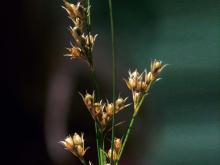Wildflowers, Grasses and Other Nonwoody Plants
Media

Species Types
Scientific Name
Agalinis tenuifolia (formerly Gerardia tenuifolia)
Description
Slender false foxglove, or common gerardia, is a small, showy wildflower with slender, opposite leaves and thin, wiry, branching stems. The small, funnel-shaped blossoms are pink or purple, with an upper lip that arches over the 4 hairy stamens.
Media

Species Types
Scientific Name
Polygala sanguinea
Description
The dense, cylindrical flower clusters of field milkwort are pink to white and, at first glance, look something like a clover head. This small annual wildflower is common in prairies, old fields, meadows, and glades.
Media

Species Types
Scientific Name
Solidago ptermicoides (formerly Aster ptarmicoides)
Description
With its white, petal-like ray florets and pale disc florets, upland white goldenrod is truly the oddball of the goldenrods: it looks like a white-flowered aster. Indeed, it used to be considered an aster.
Media

Species Types
Scientific Name
Juncus spp. and Luzula spp.
Description
Missouri has 24 species in the rush family. Distinguishing between these grasslike plants can be tricky, but it’s easy to learn some basics about the group.
Media

Species Types
Scientific Name
Carex, Schoenoplectus, Scirpus, and other genera
Description
Missouri has more than 200 species in the sedge family. Distinguishing between these grasslike plants can be difficult, but it’s easy to learn some basics about the group.
Media

Species Types
Scientific Name
Symphyotrichum spp. (formerly Aster spp.)
Description
Missouri has 24 species of New World asters in genus Symphyotrichum. Most have purple or white ray flowers and yellow disk flowers that turn reddish over time. Most bloom in late summer and fall.
Media

Species Types
Scientific Name
Chasmanthium latifolium
Description
River oats is a native cool-season grass that is common nearly statewide in bottomlands, stream valleys, and other moist places. The open, nodding, flattened flower and seed clusters are distinctive.
Media

Species Types
Scientific Name
Panicum virgatum
Description
Switchgrass is a native perennial, warm-season, clump-forming mid or tall grass. In midsummer, delicate-looking, open, multiply-branching flowering clusters rise above the foliage.
Media

Species Types
Scientific Name
Phleum pratense
Description
A native of Europe, Timothy is a common cool-season pasture grass and occurs in a wide variety of open or disturbed habitats. It is one of the worst causes of hay fever in the late spring and early summer.
Media

Species Types
Scientific Name
Elymus virginicus
Description
Virginia wild rye can be identified by its bristly seed heads, which are held erect and whose bristle-like awns stay straight. This is a common native perennial tuft-forming, cool-season midgrass usually reaching about 2–4 feet in height.
See Also
About Wildflowers, Grasses and Other Nonwoody Plants in Missouri
A very simple way of thinking about the green world is to divide the vascular plants into two groups: woody and nonwoody (or herbaceous). But this is an artificial division; many plant families include some species that are woody and some that are not. The diversity of nonwoody vascular plants is staggering! Think of all the ferns, grasses, sedges, lilies, peas, sunflowers, nightshades, milkweeds, mustards, mints, and mallows — weeds and wildflowers — and many more!





















